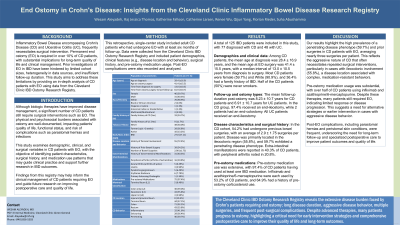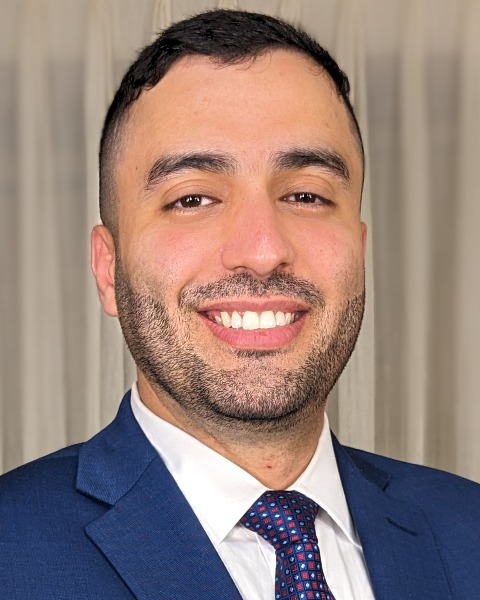Sunday Poster Session
Category: IBD
P0912 - End Ostomy in Crohn's Disease: Insights From the Cleveland Clinic Inflammatory Bowel Disease Ostomy Research Registry
Sunday, October 27, 2024
3:30 PM - 7:00 PM ET
Location: Exhibit Hall E


Wesam Aleyadeh, MD
Cleveland Clinic Akron General
Akron, OH
Presenting Author(s)
Wesam Aleyadeh, MD1, Raj Jessica Thomas, MD1, Katherine Falloon, MD2, Catherine Larson, MS3, Yueqi (Renee) Wu, MPH4, Qijun Yang, MS5, Florian Rieder, MD6, Suha Abushamma, MD5
1Cleveland Clinic Akron General, Akron, OH; 2Cleveland Clinic Foundation, Shaker Heights, OH; 3Cleveland Clinic Foundation, Cleveland, OH; 4Cleveland Clinic Lerner Research Institute, Cleveland Heights, OH; 5Cleveland Clinic, Cleveland, OH; 6Digestive Diseases and Surgery Institute; Lerner Research Institute, Program for Global Translational Inflammatory Bowel Diseases; Cleveland Clinic Foundation, Cleveland, OH
Introduction: Inflammatory Bowel Disease (IBD), including ulcerative colitis (UC) and Crohn's disease (CD), often requires surgical intervention. Permanent end ostomy (EO) is needed in 8% of UC and over 10% of CD patients, significantly impacting quality of life and clinical management. Previous studies on IBD patients with EO have been limited by small sample sizes, heterogeneous data, and short follow-up. This study aims to provide detailed descriptive data on CD patients who underwent EO from the Cleveland Clinic IBD Ostomy Research Registry.
Methods: This is a retrospective single institution study using the first ever comprehensive registry comprising IBD patients with EO created at age 18 or older with at least 6 months of follow up after EO. Data was collected on various demographic, clinical, and surgical variables and analysis was made using R Studio.
Results: 125 patients (77 CD, 48 UC) were included. In the CD cohort, 75 (97.4%) patients had an end- ileostomy, while 2 (2.6%) had an end-colostomy. The mean time from ostomy surgery to the last follow- up was 8.23 (±10.7). The mean age at diagnosis was 28.4 (±16.9) years, and the mean age at ostomy surgery was 41.4 (±15.5) years. The median time from diagnosis to surgery was 13.0 (±10.5) years. Patients were predominantly female (59.7%) and White (90.9%). A family history of IBD was reported by 28 (36.4%) patients. Half of the patients (50%) were never smokers. Regarding disease characteristics, 39 (54.2%) patients had a history of prior bowel surgery, with an average of 2.90 (±1.75) surgeries per patient. The pattern of disease was predominantly ileocolonic in 43 (55.8%) patients and penetrating in 46 (59.7%) patients. Extra-intestinal manifestations were present in 40.3% of patients, most commonly peripheral arthritis (20.8%). Pre-ostomy medication use was reported by 75 (97.4%) patients, with infliximab and azathioprine/6-mercaptopurine use each reported in 41 (53.2%) patients. Fifty (64.9%) patients reported a history of pre-ostomy oral corticosteroid use.
Discussion: Preliminary analysis of the ongoing Cleveland Clinic IBD Ostomy Research Registry offers valuable insights that could inform future clinical practice and research. This study provides a detailed demographic and clinical profile of CD patients with history of EO, highlighting the significant disease burden and surgical history in this population.
Note: The table for this abstract can be viewed in the ePoster Gallery section of the ACG 2024 ePoster Site or in The American Journal of Gastroenterology's abstract supplement issue, both of which will be available starting October 27, 2024.
Disclosures:
Wesam Aleyadeh, MD1, Raj Jessica Thomas, MD1, Katherine Falloon, MD2, Catherine Larson, MS3, Yueqi (Renee) Wu, MPH4, Qijun Yang, MS5, Florian Rieder, MD6, Suha Abushamma, MD5. P0912 - End Ostomy in Crohn's Disease: Insights From the Cleveland Clinic Inflammatory Bowel Disease Ostomy Research Registry, ACG 2024 Annual Scientific Meeting Abstracts. Philadelphia, PA: American College of Gastroenterology.
1Cleveland Clinic Akron General, Akron, OH; 2Cleveland Clinic Foundation, Shaker Heights, OH; 3Cleveland Clinic Foundation, Cleveland, OH; 4Cleveland Clinic Lerner Research Institute, Cleveland Heights, OH; 5Cleveland Clinic, Cleveland, OH; 6Digestive Diseases and Surgery Institute; Lerner Research Institute, Program for Global Translational Inflammatory Bowel Diseases; Cleveland Clinic Foundation, Cleveland, OH
Introduction: Inflammatory Bowel Disease (IBD), including ulcerative colitis (UC) and Crohn's disease (CD), often requires surgical intervention. Permanent end ostomy (EO) is needed in 8% of UC and over 10% of CD patients, significantly impacting quality of life and clinical management. Previous studies on IBD patients with EO have been limited by small sample sizes, heterogeneous data, and short follow-up. This study aims to provide detailed descriptive data on CD patients who underwent EO from the Cleveland Clinic IBD Ostomy Research Registry.
Methods: This is a retrospective single institution study using the first ever comprehensive registry comprising IBD patients with EO created at age 18 or older with at least 6 months of follow up after EO. Data was collected on various demographic, clinical, and surgical variables and analysis was made using R Studio.
Results: 125 patients (77 CD, 48 UC) were included. In the CD cohort, 75 (97.4%) patients had an end- ileostomy, while 2 (2.6%) had an end-colostomy. The mean time from ostomy surgery to the last follow- up was 8.23 (±10.7). The mean age at diagnosis was 28.4 (±16.9) years, and the mean age at ostomy surgery was 41.4 (±15.5) years. The median time from diagnosis to surgery was 13.0 (±10.5) years. Patients were predominantly female (59.7%) and White (90.9%). A family history of IBD was reported by 28 (36.4%) patients. Half of the patients (50%) were never smokers. Regarding disease characteristics, 39 (54.2%) patients had a history of prior bowel surgery, with an average of 2.90 (±1.75) surgeries per patient. The pattern of disease was predominantly ileocolonic in 43 (55.8%) patients and penetrating in 46 (59.7%) patients. Extra-intestinal manifestations were present in 40.3% of patients, most commonly peripheral arthritis (20.8%). Pre-ostomy medication use was reported by 75 (97.4%) patients, with infliximab and azathioprine/6-mercaptopurine use each reported in 41 (53.2%) patients. Fifty (64.9%) patients reported a history of pre-ostomy oral corticosteroid use.
Discussion: Preliminary analysis of the ongoing Cleveland Clinic IBD Ostomy Research Registry offers valuable insights that could inform future clinical practice and research. This study provides a detailed demographic and clinical profile of CD patients with history of EO, highlighting the significant disease burden and surgical history in this population.
Note: The table for this abstract can be viewed in the ePoster Gallery section of the ACG 2024 ePoster Site or in The American Journal of Gastroenterology's abstract supplement issue, both of which will be available starting October 27, 2024.
Disclosures:
Wesam Aleyadeh indicated no relevant financial relationships.
Raj Jessica Thomas indicated no relevant financial relationships.
Katherine Falloon: Janssen – Advisory Committee/Board Member. Pfizer – Grant/Research Support.
Catherine Larson indicated no relevant financial relationships.
Yueqi (Renee) Wu indicated no relevant financial relationships.
Qijun Yang indicated no relevant financial relationships.
Florian Rieder: 89Bio – Consultant. AbbVie – Consultant, Grant/Research Support. Adiso – Consultant. Adnovate – Consultant. Agomab – Consultant. Allergan – Advisory Committee/Board Member, Consultant. Arena – Advisory Committee/Board Member, Consultant. AstraZeneca – Advisory Committee/Board Member, Consultant. Bausch & Lomb – Consultant. Boehringer Ingelheim – Advisory Committee/Board Member, Consultant, Grant/Research Support. CDISC – Consultant. Celgene/BMS – Advisory Committee/Board Member, Consultant, Grant/Research Support. Celltrion – Consultant. Celsius – Consultant. Cowen – Consultant. Eugit – Consultant. Ferring – Consultant. Galapagos – Consultant. Galmed – Consultant. Genentech – Advisory Committee/Board Member, Consultant. Gilead – Advisory Committee/Board Member, Consultant, Grant/Research Support. Gossamer – Consultant. Granite – Consultant. Guidepoint – Consultant. Helmsley – Consultant. Horizon Therapeutics – Consultant. Image Analysis Limited – Consultant. Index Pharma – Consultant. Jannsen – Consultant. Koutif – Consultant. Landos – Consultant. Mestag – Consultant. Metacrine – Consultant. Mirum – Consultant. Mopec – Consultant. Morphic – Consultant. Myka Labs – Consultant. Organovo – Consultant. Origo – Consultant. Palisade Bio – Consultant. Pfizer – Advisory Committee/Board Member, Consultant, Grant/Research Support. Pliant – Consultant. Prometheus Biosciences – Advisory Committee/Board Member, Consultant. Receptos – Consultant. RedX – Advisory Committee/Board Member, Consultant. Roche – Advisory Committee/Board Member, Consultant. Samsung – Advisory Committee/Board Member, Consultant. Sanofi – Consultant. Surmodics – Consultant. Surrozen – Consultant. Takeda – Advisory Committee/Board Member, Consultant, Grant/Research Support. Techlab – Consultant. Teva – Consultant. Theravance – Consultant. Thetis – Consultant. Trix Bio – Consultant. UCB – Advisory Committee/Board Member, Consultant, Grant/Research Support. Ysios – Consultant.
Suha Abushamma indicated no relevant financial relationships.
Wesam Aleyadeh, MD1, Raj Jessica Thomas, MD1, Katherine Falloon, MD2, Catherine Larson, MS3, Yueqi (Renee) Wu, MPH4, Qijun Yang, MS5, Florian Rieder, MD6, Suha Abushamma, MD5. P0912 - End Ostomy in Crohn's Disease: Insights From the Cleveland Clinic Inflammatory Bowel Disease Ostomy Research Registry, ACG 2024 Annual Scientific Meeting Abstracts. Philadelphia, PA: American College of Gastroenterology.
